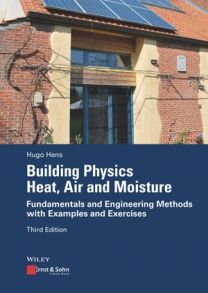Table of contents
Introduction
0.1 Subject of the book
0.2 Building physics
0.3 Importance
0.4 History
0.5 Units
0.6 Symbols
1 Heat transfer
1.1 Overview
1.2 Conduction
1.2.1 Conservation of energy
1.2.2 The conduction laws
1.2.3 Steady state
1.2.4 Transient
1.3 Heat exchange at surfaces
1.4 Convection
1.4.1 In general
1.4.2 Typology
1.4.3 Quantifying the concevtive surface film coefficient
1.4.4 Values for the convective surface film coefficient
1.5 Radiation
1.5.1 In general
1.5.2 Definitions
1.5.3 Reflection, absorption and transmission
1.5.4 Radiant bodies
1.5.5 Simple Formulae
1.6 Building-related applications
1.6.1 Surface film coefficients and reference temperatures
1.6.2 Steady state: flat assemblies
1.6.3 Local inside surface film coefficients
1.6.4 Steady state: two and three dimensions
1.6.5 Heat balances
1.6.6 Transient
1.7 Problems and solutions
2 Mass Transfer
2.1 Generalities
2.1.1 Quantities and definitions
2.1.2 Saturation degrees
2.1.3 Air and moisture transfer
2.1.4 Moisture sources
2.1.5 Air and moisture in relation to durability
2.1.6 Link to energy transfer
2.1.7 Conservation of mass
2.2 Air
2.2.1 Overview
2.2.2 Air pressure differentials
2.2.3 Air permeances
2.2.4 Airflow in open-porous materials
2.2.5 Airflow across assemblies with air-open layers, leaky joints, leaks and cavities
2.2.6 Air transfer at the building level
2.2.7 Combined heat and air flow in open-porous materials
2.3 Vapour Transfer
2.3.1 Water vapour in the air
2.3.2 Water vapour in open-porous materials
2.3.3 Vapour transfer in the air
2.3.4 Vapour flow by diffusion in open-porous materials and assemblies
2.3.5 Vapour flow by diffusion and convection in open-porous materials and assemblies
2.3.6 Surface film coefficients for diffusion
2.3.7 The surface film coefficient for diffusion applied
2.4 Moisture
2.4.1 Overview
2.4.2 Water flow in a pore
2.4.3 Vapour flow in a pore that contains water isles
2.4.4 Moisture flow in a pore that contains water isles
2.4.5 Moisture flow in materials and assemblies
2.4.6 Simplified moisture flow model
2.5 Problems and solutions
3 Combined Heat, Air and Moisture Flow
3.1 Introduction
3.2 Material and assembly level
3.3 Whole building level
3.4 Problems and solutions
Postscript


